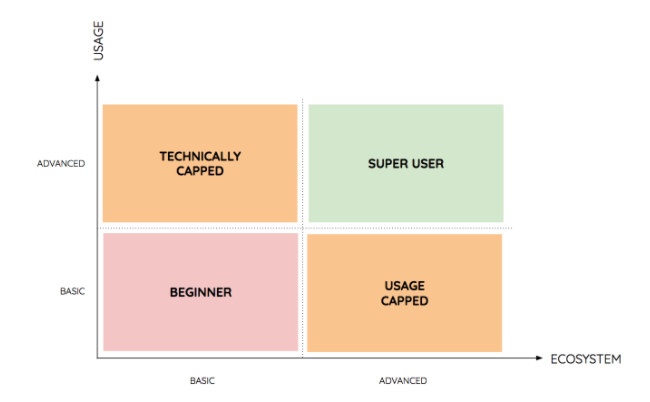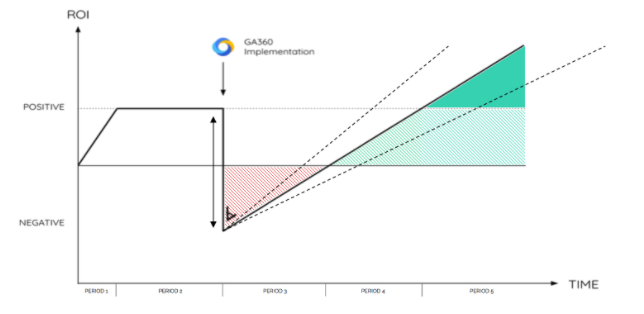More and more organisations are looking into making the switch towards the Google Analytics premium version and related paid products, called the “Google 360 suite”. It is however not always clear for marketeers and decision makers what the benefits are and if their organisation even requires such an upgrade. This article aims at helping advertisers get a better view on where they currently stand, what Google Analytics 360 entails and what the implications of adoption are. The scope of this article does not cover other Google 360 products.
A Google Analytics maturity model
The most frequently used argument for upgrading to Google Analytics 360 is the hit limit. The standard Google Analytics solution allows organisations to process 10 million hits per month. If more hits are accrued, sampling will kick in. Even though it’s a good reason to upgrade, we believe it should only be one of the reasons that defines whether a migration towards Google Analytics 360 makes sense. In order to assess the eligibility of an organisation to move towards Google Analytics 360 we have created a simple maturity assessment model. Note that this is a theoretical model / framework and should be adapted to your organisation’s context and vertical.
The model is based on two axes:
- Usage - This axis depicts the usage of Google Analytics within your organisation. If Google Analytics is part of your daily decision making process within your organisation and you’re able to drive value from insights you can consider yourself advanced. If the tools are only being used as a secondary reporting platform a basic scoring would be more appropriate.
- Ecosystem - This axis depicts to what extent your organisation owns an already advanced web infrastructure and whether this infrastructure is compatible with Google Analytics 360. Under advanced infrastructures we understand websites that have implemented a business driven measurement plan. This typically entails the use of extended dataLayers, micro- & macro conversion tracking and advanced features such as Enhance eCommerce of UserID tracking. If your organisation already deploys DoubleClick, Optimize or any other Google 360 suite compatible product the benefits of using Google Analytics 360 increase by default.

The model divides into four quadrants, each mapping a specific combination of values for both usage and ecosystem maturity. The four quadrants are:
- Beginner - Values for both usage and ecosystem are set to basic.
- Technically capped - Values for usage are set to advanced while values for ecosystem are set to basic. Organisations in this section have a strongly developed technical environment (including support) but lack your organisation and processes in order to transform this into business impact.
- Usage capped - Values for ecosystem are set to advanced while values for usage are set to basic. Organisations in this section typically see the business value but do not have the support of IT or the budget in order to further develop their infrastructure.
- Super user - Values for both usage and ecosystem are set to advanced. These are your organisations that succeed in maximising the value of a standard Google Analytics solution and find themselves capped by its abilities. As a result, these organisations are in the best position to make the jump towards Google Analytics 360 as their gain, through the availability of unlocked Google Analytics 360 features, will be immediate.
The adoption lifecycle and ROI impact
In order to set the correct expectations within organisations and to ensure the migration towards Google Analytics 360 gets the right support, organisations should look into the adoption lifecycle and ROI impact. The image below is a visual representation of that track.
 The lifecycle is divided into 5 major periods:
The lifecycle is divided into 5 major periods:
- Period 1 - Your organisation uses the standard free version of Google Analytics. The full potential of the tool has not been reached yet.
- Period 2 - Your organisation uses the standard free version of Google Analytics. The potential has been maxed out and limits are being reached. The ROI is as positive as it gets using the standard GA deployment.
- Period 3 - Your organisation migrates towards Google Analytics 360. As costs are being taken into account in the Return-On-Investment (ROI) calculation the ROI immediately drops. Not all companies will reach a negative level. The extent and impact of the drop will depends of your organisation’s context, contract price, existing deployment, scale, etc.
- Period 4 - Your organisation is now again generating a positive ROI. The overall ROI is not exceeding the ROI generated using the standard Google Analytics deployment. The slope of this curve will depend on the willingness of your organisation to further develop an integrated Google Analytics 360 process, dedicate resources and keep developing the ecosystem. As new features are unlocked, new elements have to be taken into account both in terms of usage and ecosystem. Organisations that are reluctant to do so will require a longer period to achieve a ROI positive status, if even achieved.
- Period 5 - Your organisation is able to leverage the full potential of Google Analytics 360 and the ROI reached levels that were impossible to achieve using the standard Google Analytics deployment.
All organisations looking into Google Analytics 360 solutions (as with any other technology) should take one thing into account: Technology is an enabler, not the magic itself. Both usage and ecosystem development are key in order to ensure your organisation maximizes the potential of not only Google Analytics 360, but even the standard version of the product. A proposer assessment of one’s starting position together with a concrete acceleration plan ensure organisations make the right decisions and accelerate the path towards increased ROI.Still have questions on Google Analytics 360? Semetis is an official Google Analytics 360 consultant & reseller, so don’t hesitate to reach out. We’re glad to help.
